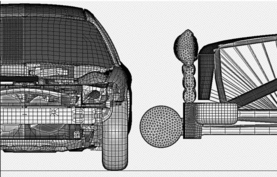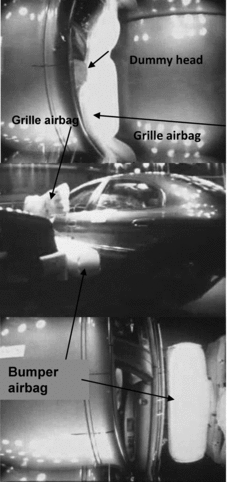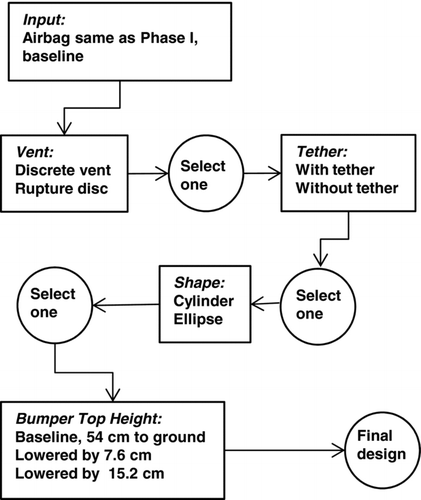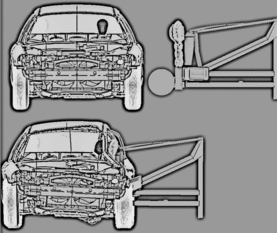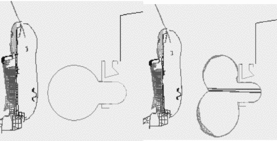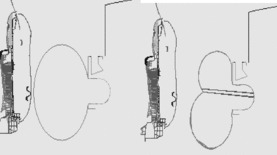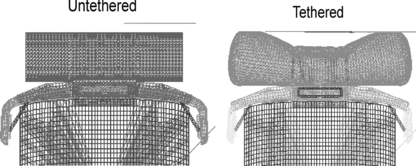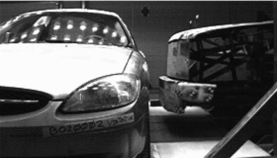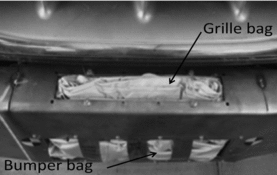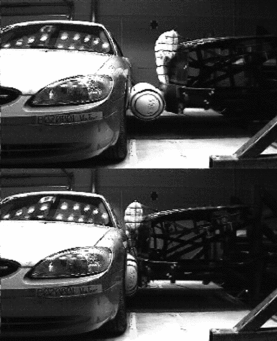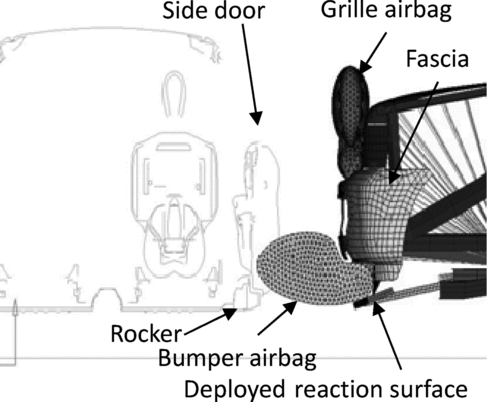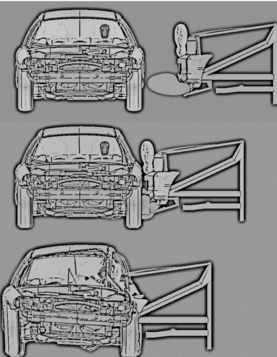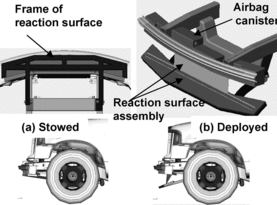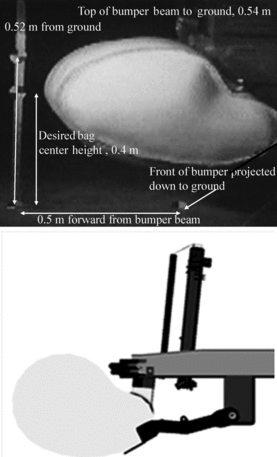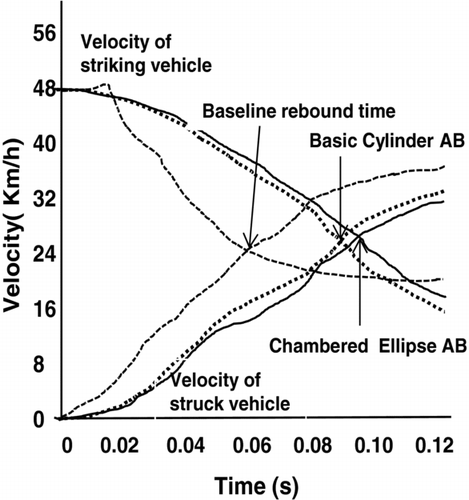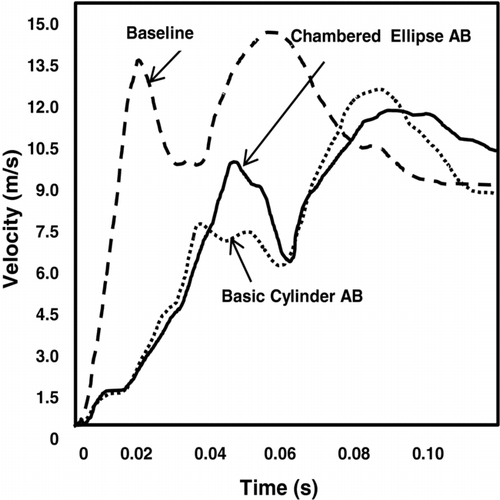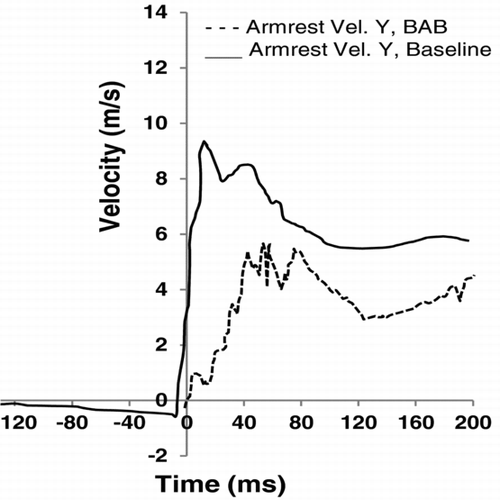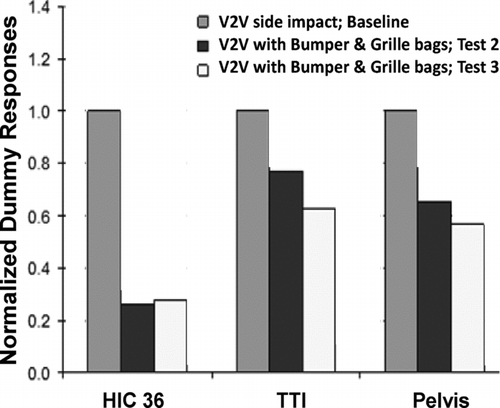Abstract
Objectives: Fundamental physics and numerous field studies have shown a higher injury and fatality risk for occupants in smaller and lighter vehicles when struck by heavier, taller and higher vehicles. The consensus is that the significant parameters influencing compatibility in front-to-side crashes are geometric interaction, vehicle stiffness, and vehicle mass. The objective of this research is to develop a concept of deployable bumper and grille airbags for improved vehicle compatibility in side impact. The external airbags, deployed upon signals from sensors, may help mitigate the effect of weight, geometry and stiffness differences and reduce side intrusions. However, a highly reliable pre-crash sensing system is required to enable the reliable deployment, which is currently not technologically feasible.
Methods: Analytical and numerical methods and hardware testing were used to help develop the deployable external airbags concept. Various Finite Element (FE) models at different stages were developed and an extensive number of iterations were conducted to help optimize airbag and inflator parameters to achieve desired targets. The concept development was executed and validated in two phases. This paper covers Phase II ONLY, which includes: (1) Re-design of the airbag geometry, pressure, and deployment strategies; (2) Further validation using a Via sled test of a 48 kph perpendicular side impact of an SUV-type impactor against a stationary car with US-SID-H3 crash dummy in the struck side; (3) Design of the reaction surface necessary for the bumper airbag functionality. The concept was demonstrated through live deployment of external airbags with a reaction surface in a full-scale perpendicular side impact of an SUV against a stationary passenger car at 48 kph. This research investigated only the concept of the inflatable devices since pre-crash sensing development was beyond the scope of this research.
Results: The concept design parameters of the bumper and grille airbags are presented in this paper. Full vehicle-to-vehicle crash test results, Via sled test, and simulation results are also presented. Head peak acceleration, Head Injury Criteria (HIC), Thoracic Trauma Index (TTI), and Pelvic acceleration for the SID-H3 dummy and structural intrusion profiles were used as performance metrics for the bumper and grille airbags. Results obtained from the Via sled tests and the full vehicle-to-vehicle tests with bumper and grille airbags were compared to those of baseline test results with no external airbags.
Introduction
Vehicle compatibility has been investigated in many studies using different approaches such as real-world crash statistics, crash testing, and computer modeling (Arbelaez et al. Citation2005, Barbat et al. Citation2007, Hollowell and Gabler Citation1997, Lugt et al. Citation1999, Nolan et al. Citation1999, Summers et al. Citation2003). Field data analysis shows that side impacts can be severe, harm-producing crashes, even though they occur less frequently than frontal impacts (Gabler Citation2003). Vehicle designs have evolved such that front ends are much stiffer than the sides of vehicles. Therefore, occupants in vehicles, particularly passenger cars, are potentially at more risk when their vehicle (the “target” vehicle) is struck from the side by another vehicle (the “bullet” vehicle) as compared to a frontal crash. The potential for increased risk for the occupant of the target vehicle results from at least two factors: there is less “crush” space in a side impact, and the “side-impact” stiffness of the target vehicle is relatively low compared to the bullet vehicle front end, particularly when struck by a vehicle with a high-mounted bumper. This problem is particularly acute when the target vehicle is a passenger car and the bullet vehicle is a truck or SUV, since the latter type of vehicles are generally stiffer in the frontal direction, have higher mass, and have higher bumpers.
Barbat et al. (Citation2007) investigated the effect of mass, geometry and stiffness on occupant responses in front-to-side impacts using computer simulations. They used a Finite Element (FE) model-based Design of Experiment (DOE) methodology and focused on discerning the effects of a few design variables on dummy responses in front-to-side vehicle crashes. The striking vehicle was selected to be an SUV while the struck vehicle was a mid-sized passenger car. It was concluded that the geometrical compatibility and interaction were the dominating factors in increasing dummy responses and side intrusions. Dummy responses in side impact were related to the side and B-pillar intrusions and door inner velocities at the instant when contact with the side impact dummy occurred. The structural stiffness and the energy absorbing capacity of the door midway between the rocker and beltline and above are significantly less compared to those of the side structure close to the rocker.
In this research, the authors have investigated the concept of external airbags on the SUV to mitigate the effect of mass, stiffness and geometrical interaction differences in SUV-to-passenger car side impacts. Some of the authors of this paper have conducted bumper airbag research in late 1999 and are co-inventors on US granted patents associated with this concept (US Patent 7,036,844, US Patent 6,923,483, US Patent 6,757,611). The bumper airbag concept for improved compatibility in front and side impacts was investigated early in 1994 by Clark and Young (Clark Citation1994, Clark and Young Citation1994). Their work involved two commercial airbags- a low pressure and a high pressure airbag, built for other purposes. The low pressure airbag was a modified “pillow bag” bladder bag, made of coated nylon and used commercially for storage of liquids or gases at less than 69 KPa pressure. The high pressure airbag was a Maxi force KPI 35L Air Lifting bag made of coated Kevlar. Clark and Young (Citation1995) carried out two crashes with 1989 Cutlass Ciera 4-door sedans equipped with bumper airbags. The first test was a frontal crash into a rigid barrier at 48.5 kph with a high pressure (221 KPa) bag, outboard and low pressure (20 KPa) bag inboard totaling 84 cm thickness. The airbags were roped together, in a Kevlar sheet attached below the bumper and above the luggage rack on the roof. The low pressure airbag ruptured as expected in the frontal impact and the external airbag system absorbed approximately 19% of the crash energy. The second test was a side impact crash in which a 48.5 kph moving rigid barrier impacted a 20 cm thick high pressure, 76 KPa, airbag mounted on the side of the passenger car above the sill, overlapping the side door and centered on the B-pillar. The result of this test was unsatisfactory due to excessive penetration of the airbag into the yielding side structure of the struck vehicle.
Moxey et al. (Citation2005) used FE analysis to investigate the effectiveness of external airbags for pedestrian impact. Their model incorporated a pedestrian model impacted by a C-class vehicle with a staged airbag system (a bumper airbag and a scuttle airbag) mounted on top of the hood. However their research was very preliminary with no hardware testing or validations. Their paper was more focused on the pre-crash sensing development and it was concluded that substantial additional work was required for the development of external airbags. A feasibility study and the development of an external airbag were conducted by the authors of this paper in two phases. The Phase I of this study is reported by Barbat et al. (Citation2013) and will be summarized in this paper.
This paper covers the details of the Phase II of the concept development of the external bumper and grille airbags for enhanced compatibility in SUV-to-passenger car side impacts. This phase consisted of component sled tests and computer simulations to develop concepts for reaction surfaces for the external airbag. A FE DOE study was conducted to establish the required bumper airbag height, deployment method and trajectory to accomplish the desired outcome. The effectiveness of the external airbag design concept, mounted on an SUV, was demonstrated in a full scale side impact test of the SUV against a passenger car at 48 kph. Results obtained from the sled and full vehicle tests with bumper and grille airbags were compared to those of baseline tests without external airbags.
Phase I: Summary of Bumper and Grille Airbags Design
The Phase 1 study, reported by Barbat et al. (Citation2013), used analytical, numerical, and hardware testing methods to help develop the initial design parameters for the external airbags concept. Simplified spring-mass models were initially developed to set the bumper and grille airbag stiffness targets. Computer simulations, validated with physical testing, were used to develop an inflatable structural system design for integrity and performance. Hardware testing at the component, subsystem and sled levels was supported by FE analyses. The test plan was executed to guide the structural integrity and the pyrotechnic inflation system of the airbags, as well as to meet the targeted collision severity reduction and deployment requirements. Tests were conducted to select the fabric material, construction technique (sewn vs. bonded bags), seam type, and energy management features (burst type vent ports).
The initial airbag shape and design parameters were determined in Phase I and carried over to Phase II for further refinements. The main purpose of the test in Phase I was to evaluate the airbag's integrity and deployment. The desired performance, in terms of dummy responses, was to be achieved in Phase II by optimizing the airbag shape and design parameters. The bumper airbag characteristics established in Phase I and carried over to Phase II research were: a 122 cm long untethered circular cylinder, an initial pressure of 105 KPa, a peak pressure of 186 KPa, and a vent pressure of 106 KPa. The bumper face in which the airbag canister was mounted at its center was 40 cm high and acted as a reaction surface to prevent the airbag from rolling backward. The Phase I FE models of the inflatable structure were developed and used for Phase II. Extensive iterations and optimization were conducted to achieve the energy management targets and help guide more efficient component test plans.
Phase II: Development Method
The development of the external airbag relied extensively on finite element simulations of the striking and struck vehicles and the airbag itself. Phase I airbag design parameters were the starting point for further DOE and iterations to refine the design to achieve the targeted structural and occupant responses. The finite element identified design parameters were implemented in physical hardware and sled tests were conducted to verify the design parameters. The process was iterative until a design solution appeared robust enough for full scale vehicle-to-vehicle crash testing. The following parts of this paper describe the FE models, modeling studies, sled and full vehicle crash tests and results.
Finite Element Models
shows the FE model simulating a 48 kph perpendicular impact of the 2177 kg SUV-type rigid buck, with mounted bumper and grille airbags, against a stationary mid-sized passenger car with the SID-H3 dummy in the driver seat. The buck construction was modeled as rigid material, because no deformation in the buck was observed in the baseline (no airbags) impact test against a passenger car at 48 kph perpendicular side impact. The reaction plate for the bumper airbag was modeled with elastic shell elements. The airbags were pre-inflated in the simulations. The passenger vehicle model was the same as that used by Barbat et al. (Citation2007). This FE model was correlated with physical FMVSS 214 and vehicle-to-vehicle front-to-side crash tests. The SUV-type sled buck model was the same as that developed by Barbat et al. (Citation2013) during the Phase I study. The buck impacted the stationary car at 48 kph. The SID-H3 responses that were monitored in this study as system responses were the Head peak acceleration, Head Injury Criterion (HIC), Thoracic Trauma Index (TTI) and the Pelvis acceleration. The nonlinear, explicit FE crash code Radioss (RADIOSS) was used for all of the simulations.
Finite Element Design Iterations
Phase I Via sled test results, obtained from the buck impacting the side of a 4-door sedan (both mounted on the sled), verified the bumper and grille airbag deployment time, venting mechanisms and time, coverage, and integrity. The grille airbag helped prevent dummy's head from contacting the leading edge of the buck's hood (see ). However, the bumper airbag did not achieve the desired performance in terms of dummy's indices for the TTI and Pelvic acceleration and did not achieve the desired intrusions and door velocity reductions. It was believed that further refinements of the bumper airbag design parameters and reaction surface design were required to achieve the desired outcome.
A DOE was conducted using the FE model shown in to adjust the airbag parameters. Airbag tethers and chambers were introduced into the model for further stability of the airbags. Two different bumper airbag shapes (circular and elliptical cylinders with and without tethers), different bumper airbag heights from the ground reference, different reaction surface heights expressed by its width in the vertical direction, and thickness were used in the DOE matrix. The airbag initial pressure, maximum pressure, and rupture disc vent pressure were also exercised in the DOE and the targeted reduction in the dummy indices and door velocity were achieved. shows a flow diagram for the DOE iterations using the FE models. Design parameters obtained from simulations that provided performance enhancements were incorporated into the airbag construction and reaction surface design. The performance was evaluated and designs parameters were verified through a 48 kph SUV-type buck mounted on a wheeled carriage impacting a stationary passenger car in perpendicular side impact test ().
Bumper Airbag Tether
FE simulations and testing identified the need to add tethers in the bumper airbag to improve its stability and performance. and show a center section of the circular and elliptical cylindrical airbags with added tethers. shows the top view of the bumper airbag with and without tethers. As shown in this figure, tethers were also added to the outboard sides of the center section to increase the airbag stability and also to reduce the dummy's pelvis acceleration levels.
Bumper Airbag Shape
FE models with two different shapes for the bumper airbag were generated. Simulations were carried out with circular and elliptical cylindrical tethered bumper airbags.
Bumper to Ground Height
Three different bumper's height, the baseline height at 54 cm from the ground, a 7.6 cm and 15.2 cm lowered heights, were used in this series of iterations. The bumper height was measured as the vertical distance from the top edge of the bumper beam to the ground.
Performance Demonstration of External Airbags Via Sled Test with Full Vehicle
A new Via sled test facility was developed to demonstrate the bumper and grille airbags concept performance. This series of tests was carried out to validate the FE models and to help achieve final designs of the airbags, reaction surface, and deployment trajectory. The final designs were to be fabricated into hardware and the final performance evaluation of the bumper and grille airbag concept was to be demonstrated through live deployment of the external airbags in a 48 kph full scale SUV-to-passenger car side impact test, similar to the IIHS side impact test protocol using the IIHS SUV-type deformable barrier.
shows the Via sled experimental set-up for evaluating the external airbags concept in side impact. It also represents the baseline test set-up in which the striking buck has no external airbags. The stationary target vehicle used in this Via sled series was a mid-size sedan. The bullet vehicle was simulated by an SUV-type rigid buck mounted on a wheeled cart on the Via and was given an initial velocity of 48 kph perpendicular to the target vehicle. The buck had a rigid vertical plate attached to the front bumper beam. The inflatable structure (airbags) and the inflator(s) were integrated into a mechanical module or canister packaged through an opening at the center of this rigid plate (see ). This plate is also used to act as a reaction surface for the bumper airbag to enhance stability and performance and to prevent the airbag from rolling under and behind the bumper beam, which negatively affects the intent of managing approximately 20% of the crash energy.
The target vehicle contained a belted, instrumented SID-H3 dummy for the driver. The driver seat was at the mid-position and the driver airbag was not activated. The target vehicle weight was 1778 kg and the buck assembly was 1822 kg. The armrest and the side structure were instrumented with accelerometers to calculate door velocity at discrete locations.
Four tests were conducted. The first one was the baseline with no external airbags (see ). The three other tests used external bumper and grille airbags mounted on the SUV-type buck, as previously described. Three different bumper airbag shapes were tested: basic circular cylinder with no chambers, chambered circular cylinder, and chambered elliptical cylinder, extending along the length of the bumper (122 cm) (e.g. shown in ). The grille airbag design in all the three tests was the same.
Table 1 Tether effect on normalized dummy responses
Table 2 Bumper airbag shape effect on normalized dummy responses
Table 3 Bumper height effect on normalized dummy responses
Table 4 Via sled test results and airbags characteristics
The bumper airbag had an initial pressure of 105 KPa, vent pressure of 172 KPa, and a 15 cm diameter rupture disc vent. The grille airbag had an initial pressure of 3.5 KPa, and no vents. The airbags were instrumented with pressure transducers and were fully inflated prior to the tests. The parameters associated with the bumper airbag used in the Via sled tests are listed in . The circular cylinder airbags were 37 cm diameter × 122 cm length, while the elliptical cylinder airbag was 37 cm diameter × 48 cm × 122 cm length. The buck, with and without external airbags, impacted the side of a stationary passenger car in a perpendicular direction at 48 kph. The results from this serious of test was analyzed and led to the development of the final airbags and reaction surface designs and deployment strategy through the use of the validated FE model.
Final CAE Iterations of External Airbags Concept Design
Analyses of the results from the last Via sled tests led to further refinement of the reaction surface design and the bumper airbag shape and deployment strategy. The new designs of the reaction surface and bumper airbag were incorporated into the FE model to simulate the via sled side impact test with the latest design. shows a new FE model that was created to develop the bumper airbag and the reaction surface at time zero (prior to contact). This model was exercised in a 48 kph side impact against a 4-door sedan, equipped with SID-H3 dummy, to optimize the new bumper airbag and reaction surface parameters and to move to the fabrication stage of these components (see ). Additionally FE simulations were conducted by keeping airbag characteristics and parameters unchanged while optimizing the reaction surface
Table 5 Door armrest velocity obtained from the Via sled tests
Table 6 Finite element results for reaction surface gauge optimization
thickness to provide further performance enhancement (see ).
Final Prototype Build and Evaluation of the External Airbags Concept
Design parameters obtained from simulations for the external airbags and the reaction surface components that provided performance enhancements were incorporated into the prototypes build. This section describes the external airbags and the reaction surface prototypes hardware, packaging the hardware into the SUV front end, the airbags characteristic, and the full scale SUV-to-passenger car side impact test for concept performance verification.
Reaction Surface and Airbags
Performance requirements dictated the special shape of the bumper airbag and the reaction surface design leading to packaging changes. The reaction surface was integrated into the bumper airbag canister. It was hinged to the canister as a door that opens down due to the force induced by the airbag deployment and held in place through hinges and fabric to act as a reaction surface to the bumper airbag. shows the details of the reaction surface assembly, in which the fabric reaction surface follows the canister at the top and is straight at the bottom. The rear tube was designed to take the load from the fabric reaction surface. The stowed condition (a) and the deployed condition (b) of the reaction surface assembly design for both the reaction surface hardware alone and when packaged on the SUV are shown in . The lower flat surface on the canister, just off center, is the mounting zone for the vent device. This allows a much more direct load transfer from the fabric reaction surface through the rear beam and into the frame. shows the prototype bumper airbag final shape, shown as deployed and supported by the reaction surface.
shows the final shape of the bumper airbag with three internal bulkheads for stability. This airbag along with the grille airbag and inflators were placed into a canister. The canister along with the reaction surface assembly was attached to the front end of a SUV for a research test. The airbags were pre-inflated and deployed, in order to verify the deployment and airbag characteristics, prior to the full scale vehicle-to-vehicle test.
Bumper and Grille Airbag Concept Design Characteristics
The selected prototype bumper airbag characteristics that were used in the final full scale vehicle-to-vehicle side impact test are listed as follows:
| • | Bag material: 2-ply, 420 Denier, Nylon 6.6 (custom woven) | ||||
| • | Bag Shape: Ellipse | ||||
| • | Flat panel dimensions (L × W × H): 122 cm Length × 64 cm Depth × 36 cm Height | ||||
| • | Three internal bulkheads and four internal tethers to maintain bag shape | ||||
| • | Volume: 175L (∼ 200L at 133 KPa) | ||||
| • | Inflators: 2 × APH1a | ||||
| • | Initial Pressure: 138 KPa | ||||
| • | Vent Pressure: 172 KPa | ||||
| • | Vent Area: 182 cm2 | ||||
The grille airbag was made of the same material with 3.45 KPa initial pressure and did not have a vent.
Full Scale Vehicle-to-Vehicle Side Impact Tests
The prototype bumper and grille airbag assemblies, described earlier, were attached to the front end of a mid-size SUV. The mid-size SUV bullet vehicle, with and without external airbags, was instrumented and tested in 48 kph perpendicular side impact against the target vehicle. The target vehicle contained an instrumented and belted SID-H3 dummy in the driver seating location with the seat in the fore/aft mid-position. The airbags in the target vehicle were not activated. The target and bullet vehicles were instrumented with accelerometers at specific points to record the crash pulses and calculate side door armrest velocities. Three full scale tests were conducted with the target vehicles being identical to those used in the Via sled tests, and the bullet vehicles were the mid-size SUV with and without bumper and grille airbags. A baseline test was conducted, i.e., no external airbags, and two tests were conducted with the bullet vehicle equipped with bumper and grille airbags. The test weight of the bullet was 2177 kg, while that of the target vehicle was 1950 kg. The conceptual compatibility enhancement was assessed through dummy responses in a struck mid-size sedan (target).
Discussion of Results
Via Sled FE Iterations Results and Discussion
FE models, shown in , were used in the DOE investigation to further refine the bumper airbag design parameters such as shape, tethers and ground clearance. The CAE results obtained from the DOE study are presented in –3. Some of the bumper airbag characteristics, such as the initial pressure, peak pressure, venting pressure and vent area, are listed in the tables and were kept constant throughout the simulations in this DOE study.
Bumper Airbag Tether Effect
The tethers shown in and were added to the bumper airbag design while keeping all other parameters, such as airbag shape and height, fixed. FE results of the SID-H3 dummy responses such as Head acceleration, TTI and Pelvis acceleration were studied. Simulation results with and without the tethers are shown in . The dummy responses in are normalized by the baseline (no airbags) values. Tethered bumper airbag provided improvement of 7.3% for the head and 5.35% for the pelvis accelerations while it degraded the TTI performance by 14.6%. While airbag's tethers provided little improvement in the dummy responses, they significantly enhanced the airbag stability and interaction with the target vehicle during the impact. The FE model showed that the TTI can be improved by adjusting the bumper airbag's ground clearance, which was also investigated in the DOE study.
Bumper Airbag Shape (Elliptical vs. Circular) Effect
Since tethered airbags demonstrated benefits, they were incorporated in the airbag model. Two different shapes of tethered bumper airbags, elliptical and circular sections were investigated, while keeping all other parameters fixed. Dummy responses for the head, thorax and pelvis, normalized by the baseline (no airbags) values are listed in . The elliptical airbag enhanced all the dummy responses (7.9% for the head peak acceleration, 8.1% for the TTI, and 28.3% for the pelvis). The elliptical bumper airbag helped increase the contact area with the struck side of the target vehicle, covering more area at the pelvis region compared to the circular section airbag. The total impact force generated by the airbag was distributed over a wider contact area which also helped improve the head and thorax responses. Therefore, it was determined that the elliptical airbag will be used for the next FE iterations.
Bumper Airbag Ground Clearance Height Effect
The next DOE FE runs consisted of lowering the bumper airbag height by 7.6 cm and 15.2 cm while keeping all other airbag parameters unchanged. The elliptical tethered airbag was used for these simulations. The normalized FE results, in terms of head, thorax and pelvis responses are presented in . Lowering the bumper airbag by 15.2 cm provided degradation in performance (negative 15.2% for the TTI and negative 36.8% for the pelvis acceleration), while lowering the airbag by 7.6 cm enhanced both the head and thorax responses (8.6% for the head acceleration, 21.5% for the TTI, and negative 2.6% for pelvis acceleration). Lowering the bumper airbag height by 7.6 cm was selected.
Via Sled Test Results and Discussion
The airbag design and shape that provided the best performance based on earlier FE results was used to construct the physical airbags and associated hardware (airbag module and housings, inflators, and flat reaction surface fixed to the front bumper face). This new series of Via sled tests, described earlier and shown in –, were carried out to validate the FE models and to evaluate performance.
Target and Bullet Buck Velocity Profiles
The time-history plots for the target vehicle and bullet buck for the four Via sled tests, described earlier, are presented in . Rebound time is the time when target and bullet reach a common velocity after which the vehicles start separating. The velocity change (delta-V) experienced by target vehicle is almost the same and is exactly the same if calculated by using momentum conservation. The effect of adding bumper airbag delays the rebound time, which results in reduced deceleration and impact forces, thus leading to lower dummy responses.
When the bullet vehicle (buck) contacted the target passenger car, the B-Pillar and the body side of the target vehicle quickly accelerated to match the velocity of the bullet (see ). In the case of the baseline impact test, the target vehicle experienced a velocity change of approximately 24 kph at the separation time of 58 ms, whereas a lower velocity change of 16 kph occurred at 58 ms in the tests with the bumper airbags. It should be noted that the occupant contacted the intruding door in the Via sled test with the bumper airbag at an earlier time of around 40 ms. The change in velocity experienced by the target vehicle is an indication of the crash severity and an indication of the intruding door/trim/armrest velocities. The preliminary expectation was lower dummy responses for the target vehicle when struck by the bullet with external airbags compared to the baseline, as shown in .
Selected Dummy Responses Time Histories Discussion
The effect of the bumper and grille airbag concept on SID-H3 responses is listed in , which also shows the airbag characteristics and test conditions. The selected Head peak acceleration, Thoracic Trauma Index (TTI), and Pelvic acceleration were normalized by their corresponding values obtained from the baseline test with no external airbags. Structural responses in terms of armrest velocity are presented in . The time histories of the armrest velocities caused by the bullet SUV-type buck with and without external airbags are presented in .
The tests with the external airbags showed reduced dummy responses, which is judged to be due to the reduction of door/armrest intrusion and reduction of door/armrest velocities during dummy contact. lists the maximum values of the armrest velocity induced by the bullet buck impact with and without the external bumper airbags. It peaked to 13.78 m/s at 18 ms and was reduced by almost half to an average of 7.5 m/s at about 38 ms, the average time-to-peak for the external airbag tests. Typically, the velocity of armrest contact can be viewed as an indicator of impact severity. Ultimately, higher armrest velocity leads to higher T1 and T12 ribs accelerations. Based on the Via sled tests results, the bumper airbag managed some of the impact energy delaying the contact time between the armrest and the dummy, which in this case occurred at contact speeds almost half of that of the baseline impact test with no airbags. The grille airbag helped prevent the dummy's head from contacting the leading edge of the buck's hood compared to that of the baseline in which head contact occurred. However, the via sled tests and the final simulation results presented in indicated that the bumper airbag needed to be deployed low enough to engage the rocker of the struck vehicle to effectively function as desired. This led to the final shape design of the bumper airbag and the deployment strategy to engage the rocker during the initial impact.
Firing Time and Airbag Deployment
Two inflators were used to inflate the bumper airbag. The first was fired at 150 ms before impact and the second inflator was fired 25 ms after the first, i.e. at 125 ms before impact. Similarly, two inflators were used for the grille airbag. The first one was fired at 55 ms before impact and the second one was fired at 25 ms after the first. The sequence of the deployment of the bumper and grille airbags in one of the conducted tests is shown in .
Vehicle-to-Vehicle Test Results and Discussion
Vehicle-to-Vehicle Test Results
Live deployment of the prototype bumper and grille airbags in a full scale 90 degree, 48 kph side impact was carried out to evaluate the potential effectiveness of the concept. The prototype bumper airbag described in – was used for the final phase of verification. All lessons learned from the Via sled tests and simulations were incorporated in the final design of the prototype system. The three tests described earlier were deemed successful tests because the airbags performed as expected and the desired deployment, stability, and integrity of the airbags were maintained.
The results for armrest velocity obtained from the impact by the bullet vehicle with and without external airbags are presented in . It shows that the test conducted with a bumper airbag resulted in a reduction of the armrest velocity by 40% (10m/s at 17ms to 6m/s at 40ms). This is an indication of overall reduction in side impact intrusion. shows the target vehicle driver dummy responses for each crash test. The tests with external airbags had reduced HIC (36ms) by 73%, TTI by 31%, and the pelvis acceleration by 39% for the dummy. The average results of the responses obtained from the two repeat tests of the SUV with external airbags was used for the percentage calculations.
This futuristic external airbag concept requires highly reliable pre-crash sensors for target vehicle recognition and timely deployment of the airbags to help minimize false positive triggering. The development of the required sensors has not been addressed in this paper and was beyond the scope of this research. Recently introduced safety features such as curtain airbags in passenger cars offer additional opportunities for enhanced front-to-side compatibility and self-protection of vehicle occupants, whereas the concept of external airbags may also have potential in mitigating pedestrian injuries.
Conclusion
| • | The concept design of the prototype bumper and grille airbags was successfully demonstrated through a live deployment in full scale SUV-to-passenger car perpendicular side crash tests. | ||||
| • | Head peak acceleration, Head Injury Criteria (HIC), Thoracic Trauma Index (TTI), and Pelvic acceleration of the SID-H3 dummy were used as performance metrics for the bumper and grille airbags. | ||||
| • | In the tests conducted, the external airbag concept maintained integrity and reduced dummy responses and structural intrusions for the target vehicle. | ||||
| • | The external airbags were developed and evaluated by means of FE simulations and Via sled testing. | ||||
| • | The concept design parameters of the bumper and grille airbags were presented. Full vehicle-to-vehicle crash test results, Via sled test, and simulation results were also presented. | ||||
| • | This research provided lessons learned and helps set direction for future research and development of external airbags. | ||||
| • | There are major limitations which may hinder making this concept production feasible such as packaging of the airbags, inflators, and reaction surface. Most importantly, airbags deployment is irreversible and requires very reliable and robust pre-crash sensors in all weather conditions and day or night. Currently, these types of pre-crash sensing systems are not available for the automotive environment. | ||||
| • | An additional requirement is that the bumper airbag system functions in a frontal barrier impact and does not compromise any other FMVSS 208 test results. | ||||
Acknowledgments
The authors would like to acknowledge the contributions made by the BF GOODRICH's Automotive (currently out of business) team members who worked with the authors on this project.
© Saeed Barbat, Xiaowei Li, and Priya Prasad
References
- Arbelaez , R B , Baker , B C and Nolan , J M . Delta Vs for IIHS side impact crash tests and their relationship to real world crash severity . Paper presented at: 19th International Technical Conference on the Enhanced Safety of Vehicles; Paper 05-0049, June 6–9 , Washington , DC
- Barbat , S , Li , X and Prasad , P . Front-to-side crash compatibility analysis using a CAE based methodology . Paper presented at: 20th International Technical Conference on the Enhanced Safety of Vehicles; Paper 07-0347, June 18–21 , Lyon , , France
- Barbat , S , Li , X and Prasad , P. Bumper and grille airbags concept for improved vehicle compatibility in side impact: Phase I . Paper presented at: 23rd International Technical Conference on the Enhanced Safety of Vehicles; Paper 0140, May 27–30 , Seoul , Korea
- Clark , C. The crash anticipating extended airbag bumper . Paper presented at: 14th International Technical Conference on the Enhanced Safety of Vehicles; May 1994 , Munich , , Germany
- Clark , C and Young , W A . 1994 . Airbag bumper just inflated before the crash , Detroit , MI : SAE International . Paper No. 941051
- Clark , C and Young , W A . 1995 . Car crash theory and tests of airbag bumper systems , Detroit , MI : SAE International . Paper No. 951056
- Gabler , HC. 2003 . The evolution of side crash compatibility between cars, light trucks and vans , Detroit , MI : SAE International . Paper No. 2003–01–0899
- Hollowell , W T and Gabler , HC. NHTSA's vehicle aggressivity and compatibility research program . Paper presented at: 15th International Technical Conference on the Enhanced Safety of Vehicles; Paper No 96-S4-O-01 , Melbourne , , Australia May 13–17
- Lugt , D V , Connoly , T and Bhalsod , D. 1999 . Vehicle compatibility – analysis of the factors influencing side impact occupant injury , Detroit , MI : SAE International . Paper No. 1999–01–0067
- Moxey , E , Johnson , N , McCarthy , M and McLundi , W. 2005 . Advanced protection for vulnerable road users , Detroit , MI : SAE International . Paper No. 2005–01–1870
- Nolan , J , Powell , M , Preuss , A and Lund , A. Factors contributing to front-side compatibility: a comparison of crash test results . Paper presented at: 43rd Stapp Car Crash Conference, Paper No. 99SC02, October 25–27 , San Diego , CA
- RADIOSS, Finite Element Crash Code, Altair Engineering Inc .
- Summers , S , Hollowell , T and Prasad , A . NHTSA's research program for vehicle compatibility. 18th International Technical Conference on the Enhanced Safety of Vehicles . Nagoya , , Japan Paper 307, May 19–22
- US Patent . Bumper Airbag with Multiple Chambers . Patent No. 7, 036, 844
- US Patent . Bumper Airbag and System . Patent No. 6, 923, 483
- US Patent . Method for Operating a Pre-Crash Sensing System in a Vehicle Having External Airbags . Patent No. 6, 950, 014
- US Patent . Adaptive Safety System for a Bumper-Bag Equipped Vehicle . Patent No. 6, 757, 611
